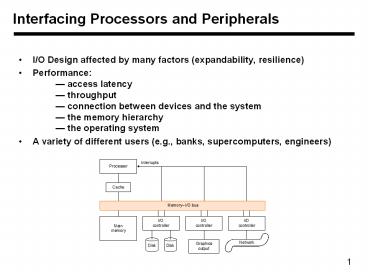Interfacing%20Processors%20and%20Peripherals - PowerPoint PPT Presentation
Title:
Interfacing%20Processors%20and%20Peripherals
Description:
Interfacing Processors and Peripherals I/O Design affected by many factors ... Keyboard. input. human. 0.01 Mouse. input. human. 0.02 Voice input. input. human. 0.02 ... – PowerPoint PPT presentation
Number of Views:106
Avg rating:3.0/5.0
Title: Interfacing%20Processors%20and%20Peripherals
1
Interfacing Processors and Peripherals
- I/O Design affected by many factors
(expandability, resilience) - Performance access latency throughput
connection between devices and the system the
memory hierarchy the operating system - A variety of different users (e.g., banks,
supercomputers, engineers)
2
I/O
- Important but neglected The difficulties in
assessing and designing I/O systems have often
relegated I/O to second class status courses
in every aspect of computing, from programming
to computer architecture often ignore I/O or
give it scanty coverage textbooks leave the
subject to near the end, making it easier for
students and instructors to skip it! - GUILTY! we wont be looking at I/O in much
detail be sure and read Chapter 8 in its
entirety. you should probably take a
networking class!
3
I/O Devices
- Very diverse devices behavior (i.e., input vs.
output) partner (who is at the other end?)
data rate
4
I/O Example Disk Drives
- To access data seek position head over the
proper track (8 to 20 ms. avg.) rotational
latency wait for desired sector (.5 / RPM)
transfer grab the data (one or more sectors) 2
to 15 MB/sec
5
I/O Example Buses
- Shared communication link (one or more wires)
- Difficult design may be bottleneck length
of the bus number of devices tradeoffs
(buffers for higher bandwidth increases
latency) support for many different devices
cost - Types of buses processor-memory (short high
speed, custom design) backplane (high speed,
often standardized, e.g., PCI) I/O (lengthy,
different devices, standardized, e.g., SCSI) - Synchronous vs. Asynchronous use a clock and a
synchronous protocol, fast and small but every
device must operate at same rate and clock skew
requires the bus to be short dont use a clock
and instead use handshaking
6
Some Example Problems
- Lets look at some examples from the
text Performance Analysis of Synchronous vs.
Asynchronous Performance Analysis of Two Bus
Schemes
7
Other important issues
- Bus Arbitration daisy chain arbitration (not
very fair) centralized arbitration (requires
an arbiter), e.g., PCI self selection, e.g.,
NuBus used in Macintosh collision detection,
e.g., Ethernet - Operating system polling interrupts DMA
- Performance Analysis techniques queuing
theory simulation analysis, i.e., find the
weakest link (see I/O System Design) - Many new developments
8
Multiprocessors
- Idea create powerful computers by connecting
many smaller ones good news works for
timesharing (better than supercomputer)
vector processing may be coming back bad news
its really hard to write good concurrent
programs many commercial failures
9
Questions
- How do parallel processors share data? single
address space (SMP vs. NUMA) message passing - How do parallel processors coordinate?
synchronization (locks, semaphores) built into
send / recieve primitives operating system
protocols - How are they implemented? connected by a
single bus connected by a network
10
Some Interesting Problems
- Cache Coherency
- Synchronization provide special atomic
instructions (test-and-set, swap, etc.) - Network Topology
11
Concluding Remarks
- Evolution vs. Revolution More often the
expense of innovation comes from being too
disruptive to computer users Acceptanc
e of hardware ideas requires acceptance by
software people therefore hardware people should
learn about software. And if software people
want good machines, they must learn more about
hardware to be able to communicate with and
thereby influence hardware engineers.































